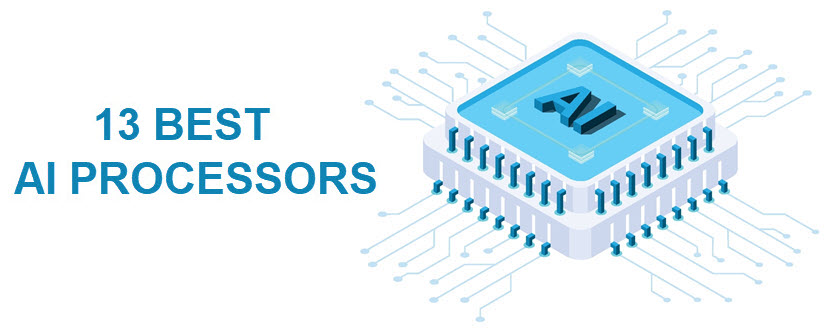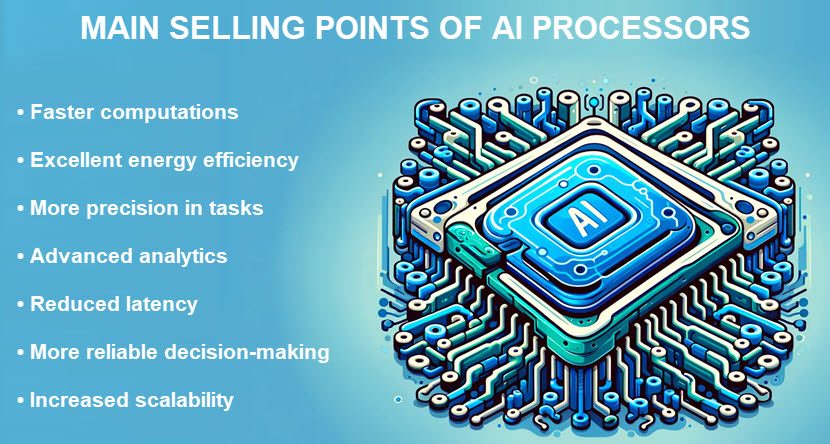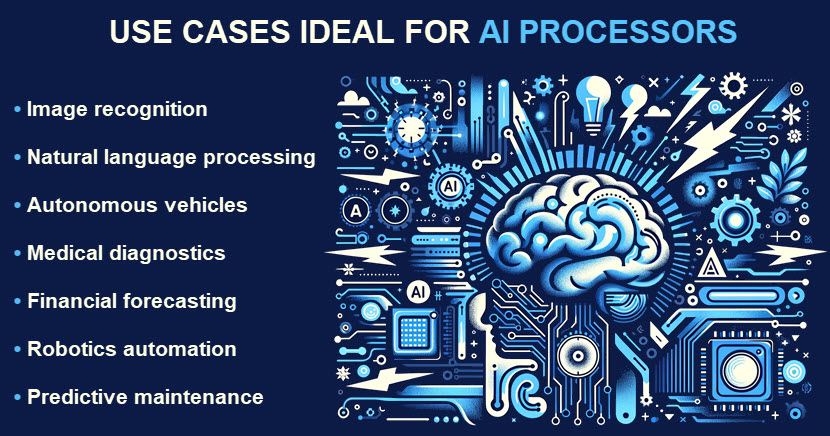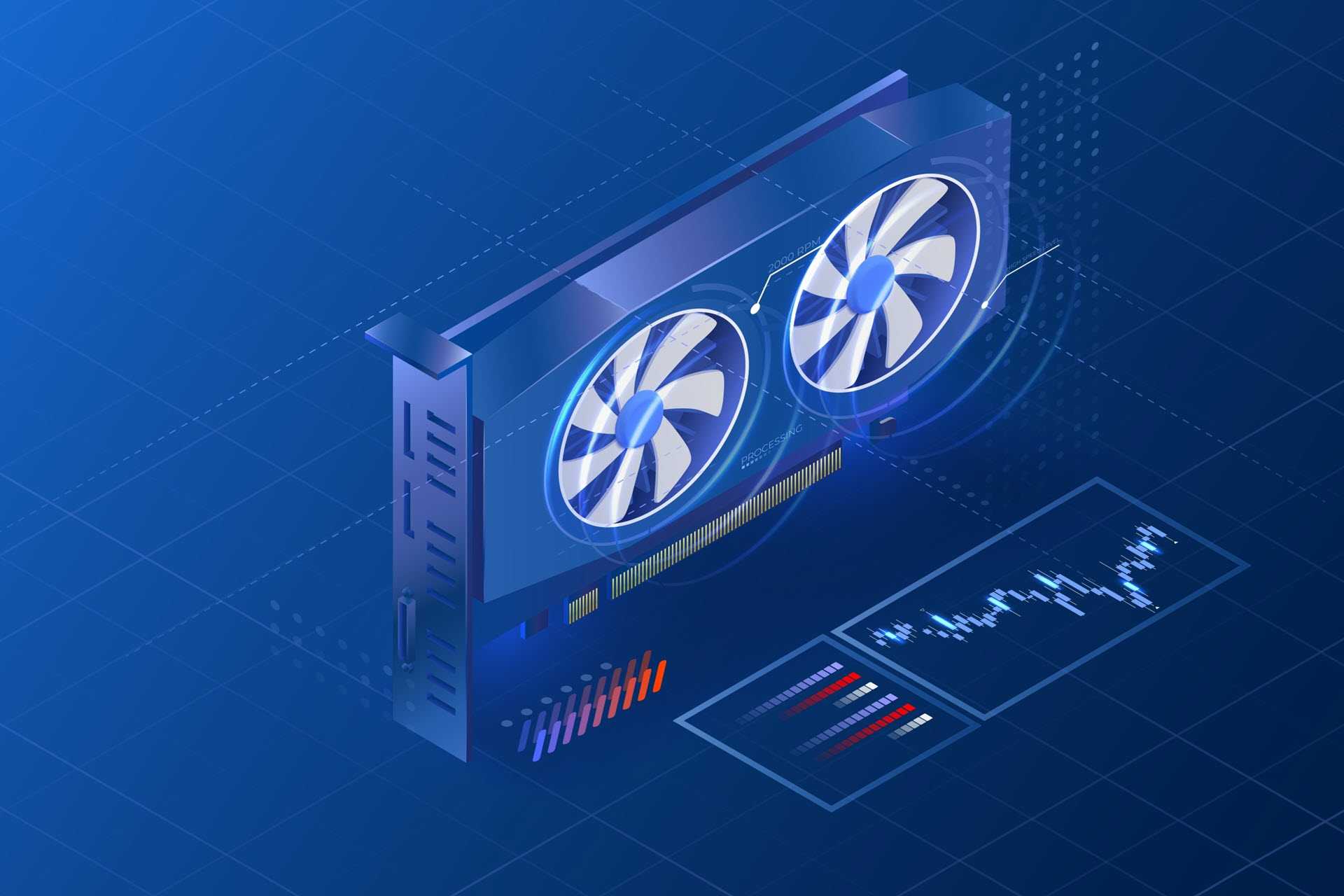AI processors are specialized hardware components designed to perform complex mathematical computations efficiently. Unlike a general-purpose CPU, an AI processor is specifically designed to handle matrix multiplications and other AI computations.
All AI processors have parallel processing capabilities, high memory bandwidth, and an architecture tailored to AI workloads. Each product serves a specific purpose and a target customer base, so we're here to help you pick the right AI processor for your use case.
This article presents the market's best AI processors ideal for advanced AI use cases, such as deep learning models and generative AI applications. Jump in to learn what sets each processor on our list apart and see which one best aligns with your IT needs and priorities.

McKinsey & Company expects AI-related semiconductors to reach $67 billion in annual sales by 2025. If that projection comes true, AI processors will make up approx. 20% of all computer chip demand.
AMD Instinct™ MI300X Accelerators
The AMD Instinct MI300X accelerators deliver exceptional performance for generative AI workloads and high-performance computing (HPC) apps. Built on the AMD CDNA 3 architecture, these accelerators offer the following features:
- Top-tier performance. AMD Instinct MI300X offers top-tier processing capabilities thanks to 153 billion transistors, 304 separate compute units, and 192 GB of High Bandwidth Memory (HBM3). These accelerators have a peak theoretical memory bandwidth of 5.3 TB/s.
- Precision capabilities. These accelerators support a broad range of precision capabilities, from highly efficient INT8 and FP8 (including sparsity support for AI) to the most demanding FP64 for HPC.
- Peak AI and HPC performance. The AMD Instinct MI300X accelerators offer a maximum throughput of 1307.4 teraflops for Tensor Float 32 operations, 2614.9 teraflops for both FP16 and BF16 operations, and 5229.8 teraflops for FP8 operations.
- AMD Instinct MI300A APUs. These accelerated processing units (APUs) are a common choice for data centers looking to accelerate the convergence of AI and HPC. APUs combine the power of AMD Instinct accelerators and AMD EPYC processors with shared memory.
AMD Instinct MI300X Accelerators are ideal for advanced generative AI workloads, such as natural language processing, computer vision, and speech synthesis. These processors are also well-suited for HPC use cases involving complex scientific simulations, climate modeling, or financial analysis.
When selecting AI processors, it helps to understand the functioning of GPUs. Our article on Tensor Cores vs. CUDA Cores explains their roles and applications.
Wafer-Scale Engine (WSE-2)
The Wafer-Scale Engine 2 (WSE-2) is a semiconductor designed by Cerebras Systems, a company specializing in AI hardware. WSE-2 accelerates AI workloads, and its customers are research institutions, large corporations, and cloud providers with large-scale AI projects (natural language processing, computer vision, deep learning simulations, etc.).
Here are the most notable features of the WSE-2:
- Largest chip on the market. This AI processor encompasses an entire silicon wafer, making WSE-2 the largest chip ever manufactured. This chip's size is 46,225 mm², which is approximately 56 times larger than the size of the largest CPU.
- Compute units. WSE-2 contains 2.6 trillion transistors and 850,000 cores designed for AI workloads. The number of cores and transistors enables unparalleled computational throughput for neural network processing.
- Memory integration. The WSE-2 has 40 GB of on-chip memory, which can be accessed at a rate of 20 petabytes per second (Pb/s). This design reduces latency and increases the bandwidth available for data processing.
- High speeds. WSE-2 is capable of 220 petaFLOPS of compute, a level of performance that significantly speeds up large-scale AI training and inference tasks.
- Andromeda. Cerebras combined 16 WSE-2 chips into one cluster to create Andromeda. This design has 13.5 million AI-optimized cores, which enables Andromeda to provide up to 1 Exaflop of AI computing (the equivalent of almost one quintillion operations per second).
Integrating a vast number of cores and a high amount of on-chip memory enables the WSE-2 to perform AI tasks at incredible speeds. The unique architecture also minimizes the need for data to travel long distances between processors and memory units, reducing communication overhead and improving overall performance on large-scale AI models.
5th Gen Intel® Xeon® Processors
The 5th Gen Intel Xeon processor offers up to 42% better AI performance and 1.84x average performance than its 4th Gen predecessor (which remains a solid AI processor in its own right). Here's what 5th Gen Xeon processors have to offer:
- AI acceleration. These processors have AI acceleration in each of up to 64 cores, making them well-suited for handling demanding AI workloads. Built-in Advanced Matrix Extensions (Intel AMX) and a larger last-level cache enhance AI inference and training performance.
- DDR5 memory. DDR5 supports up to 5,600 MT/s, which is a 66% improvement over DDR4. This memory type enables 5th Gen Xeon processors to offer better performance, capacity, and power efficiency than older Intel generations.
- PCIe 5.0. 5th Gen Xeon processors have up to 80 lanes of PCIe 5.0. This feature makes the device ideal for fast networking, high-bandwidth accelerators, and high-performance storage devices. 5th generation processors also support Compute Express Link CXL types 1, 2, and 3.
- HPC suitability. Xeon processors have Advanced Vector Extensions 512 (AVX-512), a built-in accelerator with ultra-wide 512-bit vector operations capabilities. AVX-512 makes these processors well-suited for demanding HPC computations.
- Software compatibility. 5th Gen Intel Xeon processors are software- and platform-compatible with the previous generation of Intel Xeon processors.
5th Gen Intel Xeon processors excel in a range of AI use cases. These processors are ideal for generative AI models (large language models and text-to-image generation), recommender systems, natural language processing, and image classification.

The NVIDIA GH200 Grace Hopper™ Superchip
The NVIDIA GH200 Grace Hopper Superchip is an accelerated CPU designed for giant-scale AI and HPC apps. Here's a closer look at what the Grace Hopper offers:
- Architecture mix. The GH200 combines the NVIDIA Grace and Hopper architectures with the NVIDIA NVLink-C2C. This design establishes a coherent memory model between CPU and GPU components, accelerating AI and HPC apps.
- Top-tier speed. The Grace Hopper offers 900 GB/s of coherent interface, which is approximately 7x faster than PCIe Gen5 processors. This speed makes the chip sufficient for heavy generative AI workloads, including large-language models like ChatGPT.
- AI acceleration. The Grace Hopper supercharges accelerated computing and generative AI with HBM3 and HBM3e GPU memory.
- NVIDIA software support. This processor supports all major NVIDIA software and libraries, including NVIDIA AI Enterprise, HPC SDK, and Omniverse.
The GH200 is ideal for tasks such as large language model training, recommender systems, and graph neural networks (GNNs). NVIDIA offers the chip as a part of its scalable design for hyperscale-level data centers.
Second-Generation Colossus™ MK2 GC200 IPU
The second-generation Colossus MK2 GC200 IPU is a processor developed by Graphcore, a UK-based company specializing in AI and ML hardware. The second-generation MK2 GC200 offers an 8x performance step-up compared to the MK1 IPU series.
The MK2 GC200 IPU accelerates AI research and deployment with high parallelism and memory bandwidth. Here are a few standout features of the GC200 IPU:
- Extreme parallel computing. The GC200 boasts 59.4 billion transistors and 1,472 independent processor cores, each designed to support complex AI algorithms. Massive parallelism (almost 9,000 independent parallel program threads) enables the processor to perform calculations faster than any classic CPU or GPU.
- Memory specs. The advanced GC200 architecture delivers one petaFLOP of AI compute, with 3.6 GB in-processor memory and up to 256 GB streaming memory.
- Flexible architecture. Graphcore's IPU enables the implementation of various ML models and algorithms. This flexibility stems from the chip's unique architecture optimized for the sparse, irregular computations standard in AI workloads.
- Poplar. Colossus MK2 GC200 IPU is co-designed from the ground up with the Poplar SDK, which simplifies deployments and accelerates machine intelligence.
- IPU-Fabric scalability. Adopters can interconnect the GC200 with other IPUs using Graphcore's ultra-low latency IPU-Fabric. That way, organizations get to build large-scale AI environments of up to 64,000 IPUs.
Learn about the different deep learning frameworks and see how pre-programmed workflows enable you to develop and train a deep learning network quickly.
Cloud AI 100
The Cloud AI 100 is an AI inference accelerator chip designed by Qualcomm Technologies. This chip provides high-performance AI inference processing for a wide range of advanced apps. Here's what you must know about Cloud AI 100:
- High performance. The Cloud AI 100 delivers high throughput and efficient processing for AI inference tasks. The chip easily handles various AI workloads, including those commonly used in natural language processing and computer vision.
- Smart design. This accelerator can have up to 16 AI cores, which achieve up to 400 TOPS of INT8 inference. The chip's memory subsystem has four 64-bit LPDDR4X memory controllers that run at 2100MHz, balanced with a massive 144MB of on-chip SRAM cache.
- Power efficiency. Cloud AI 100 is highly energy efficient. Low power requirements make this processor ideal for edge computing devices and data centers looking to reduce energy consumption.
- AI model support. The accelerator supports various AI models, including convolutional neural networks (CNNs) and recurrent neural networks (RNNs). Cloud AI 100 also has comprehensive software support, including tools and frameworks that facilitate easy deployment of AI models.
The Cloud AI 100 is ideal for use cases that require efficient and powerful AI inference capabilities. Go-to use cases are video processing, inference tasks in cloud computing environments, apps in low-latency edge devices, and big data workloads.
Cortex-M55
The Cortex-M55 processor, developed by Arm, introduces multiple improvements over its predecessors, particularly in the areas of AI and digital signal processing (DSP).
Cortex-M55 offers up to 15x machine learning performance improvement and 5x signal processing speeds compared to other Cortex-M processors. Here are the main features of the Cortext-M55 processor:
- Helium tech. Cortex-M55 is integrated with Arm Helium, an M-Profile Vector Extension (MVE) for the Armv8.1-M architecture. Helium enhances the processor's ability to handle complex computations.
- Enhanced AI and DSP. The Cortex-M55 accelerates AI inference and DSP workloads at the edge, making it well-suited for sensor processing and low-power ML inference.
- Ethos-U55 NPU. Organizations can pair Cortex-M55 with the Arm Ethos-U55 Neural Processing Unit (NPU) to further boost performance. This combination allows for an up to 480x increase in ML performance over previous Cortex-M processors.
The Cortex-M55 processor is highly suitable for embedded and IoT devices that require efficient processing. The usual use cases are smart sensors and decision-making edge devices.

Cloud TPU v5e
Cloud TPU v5e is Google Cloud's latest generation AI accelerator for cloud-based deployment. These powerful Tensor Processing Units (TPUs) are ideal for medium and large-scale training and inference tasks. Here are the key details:
- AI optimization. Cloud TPU v5e is optimized for transformer-based, text-to-image, and Convolutional Neural Network (CNN) training. Each TPU v5e chip provides up to 393 trillion operations TOPS, enabling fast predictions for complex models.
- Pod design. A TPU v5e pod consists of 256 chips interconnected via ultra-fast links. Each chip contains one TensorCore for matrix multiplication. Each pod delivers up to 100 quadrillion operations per second (equivalent to 100 PetaOps of compute power).
- Cost efficiency. Compared to its predecessor (Cloud TPU v4), TPU v5e delivers up to 2x higher training performance per dollar and up to 2.5x inference performance per dollar. TPU v5e is also twice as cheap as TPU v4.
- Compatibility. TPU v5e integrates with Google Kubernetes Engine (GKE) and Vertex AI, plus it supports PyTorch, JAX, and TensorFlow 2.
Cloud TPU v5e is a powerful AI accelerator ideal for machine learning tasks. Go-to use cases include image generation, speech recognition, large-scale training of machine learning models, and generative AI chatbots.
M1076 AMP
The M1076 Analog Matrix Processor (AMP), developed by Mythic AI, is a powerful chip designed for high-end edge AI apps. The M1076 AMP uses analog computation to perform AI tasks. This design enables the processor to execute complex AI models with reduced power consumption and increased efficiency.
Here are the key features of the M1076:
- On-chip execution. The M1076 AMP executes deep neural network (DNN) models directly on the chip. This design eliminates the need for external dynamic random-access memory (DRAM) and lowers latency.
- Pre-qualified models. Mythic offers a library of pre-qualified DNN models, including object detection, classification, and scene segmentation. All models are developed in standard frameworks (Pytorch, Caffe, or TensorFlow).
- High performance. The M1076 AMP delivers up to 25 TOPS in a single chip, a compute power that allows the AMP to handle complex AI workloads efficiently.
- Low power consumption. Despite offering high computing capabilities, the M1076 AMP requires just 3 watts of power for its peak performance. Low consumption makes the M1076 AMP highly suitable for power-sensitive edge IoT apps.
- Scalability. Adopters can set up configurations with multiple M1076 processors to tackle larger AI apps. For example, a PCIe card utilizing 16 M1076 AMP devices provides 400 TOPS with a total power consumption of under 75 watts.
The M1076 AMP combines high performance, low power consumption, and on-chip execution to enable efficient AI inference. The M1076 AMP comes in a 19mm x 15.5mm BGA package, making it suitable for space-constrained edge servers.
Learn about edge servers and see how these devices enable low-latency use cases at the network's edge.
Grayskull™ e150
The Grayskull AI processor by Tenstorrent efficiently runs AI/ML workloads on a reconfigurable mesh of energy-efficient chips. Tenstorrent optimized this processor for making predictions or decisions based on pre-trained machine learning models.
Here's what you need to know about Grayskull e150:
- Architecture. Each e150 card features 120 Tensix cores, with each core housing five smaller RISC-V cores and dedicated accelerators. This design enables the AI processor to reach a peak performance of around 98 TFLOPs.
- Memory specs. The Tensix array has 120MB of local SRAM and eight channels of LPDDR4 that support as many as 16 lanes of PCIe 4.0 and 16 GB of external DRAM.
- Local processing. This AI processor facilitates local data processing without relying on cloud services. This feature makes Grayskull e150 appealing to businesses with privacy-sensitive and local deployment needs.
- Key models. Grayskull supports a wide range of models, including BERT (natural language processing tasks), ResNet (image recognition), Whisper (speech recognition and translation), YOLOv5 (real-time object detection), and U-Net (image segmentation).
The Grayskull e150 fits a range of use cases that benefit from its efficient and high-performance design. The most common applications include image analysis on resource-constrained edge devices (cameras, sensors, drones, etc.). The processor can handle use cases involving NLP and autonomous vehicles if you scale the system with multiple Grayskull deployments.
Hailo-8 AI Accelerator
The Hailo-8 AI accelerator is an AI processor designed to efficiently run low-latency AI and ML workloads at the network's edge. Hailo-8 offers one of the best TOPS/$ ratios of all AI processors suitable for edge deployments. Here's what sets Hailo-8 apart:
- Innovative architecture. Hailo-8's architecture is optimized for the execution of deep learning operations. The processors deliver 26 TOPS while maintaining low power consumption (approx. 2.5 watts of power), a feature crucial for battery-operated devices.
- Support for neural networks. The Hailo-8 architecture supports many neural network types, including convolutional neural networks (CNNs), recurrent neural networks (RNNs), and fully connected networks.
- Framework support. The processor works seamlessly with popular AI frameworks like TensorFlow, TensorFlow Lite, Keras, PyTorch, and ONNX.
- A comprehensive SDK. Hailo-8 offers a software development kit that simplifies the integration of the accelerator into existing systems. The SDK includes tools for model optimization, compilation, and deployment.
High performance, power efficiency, and compact design make Hailo-8 AI accelerators ideal for deployment in edge devices such as smart cameras, autonomous vehicles, drones, and industrial robots.
Check out pNAP's edge computing servers to see how we help our clients deliver services no matter where their customers reside.
Telum
IBM's Telum is an AI processor designed to enable real-time AI inference directly within the chip. These processors provide longevity and stability in critical environments, such as financial services, healthcare, and other sectors where reliability and security are paramount.
Here is what you must know about the Telum processor:
- On-chip AI accelerator. Telum's integrated AI accelerator is designed to perform high-speed AI inference. The dedicated accelerator is optimized for high-speed AI inference, enabling Telum to execute complex neural network models.
- Advanced architecture. IBM built Telum on a 7nm process technology. This AI processor features eight cores running at over 5GHz, a design that provides the high-speed processing power needed for complex AI models and workloads.
- Large cache design. This AI processor has 32MB of cache per core, totaling 256MB for the entire chip. The large cache is crucial for speeding up data access times and improving performance for data-intensive AI tasks.
- Scalability. Telum is highly scalable and supports systems linked together for more robust AI processing. This feature is vital for companies that want to increase their AI processing power as data or workload demands grow.
Telum can enhance a wide range of apps without the latency associated with off-chip AI processing. This AI processor is ideal for fraud detection during transactions, advanced customer interactions, and risk analysis.
Gaudi2
Developed by Habana Labs, Gaudi2 is an AI processor designed for training deep learning models. The processor offers high efficiency and performance for AI workloads. Here are the key features and highlights of the Gaudi2 processor:
- Deep learning training. Gaudi2 includes specialized hardware components designed to accelerate neural network models. The processor has 24 Tensor Processor Cores and dual matrix multiplication engines to ensure efficient AI computations.
- Memory specs. Gauid2 has integrated 96 GB HBM2E memory on board for data storage and 48 MB SRAM for fast access to frequently used data.
- Scalability. Gaudi2 works as a standalone processor for small-scale AI tasks, but adopters can integrate these processors into larger, clustered environments. Scalability is also cost-efficient since every chip has 24x 100 Gigabit Ethernet (RoCEv2) ports.
- Ready-made models. Habana Optimum Library provides access to over 50,000 AI models for running on Gaudi2 processors.
- Software ecosystem. Intel's acquisition of Habana Labs means adopters of Gaudi2 have access to various frameworks, libraries, and tools that streamline the deployment of AI models.
The Gaudi2 processor is ideal for various AI training and inference tasks. These AI processors easily handle everything from natural language processing and computer vision to recommendation systems and predictive analytics.
AI Processors: More Than Enough Options to Make a Choice
A surge in popularity and rapid advancements made AI hardware a highly competitive market. An increasing number of AI processors is great news for organizations interested in developing and deploying AI-based systems. You cannot go wrong with any AI processor discussed above, so use what you learned here to choose a piece of hardware that best meets your IT requirements.



